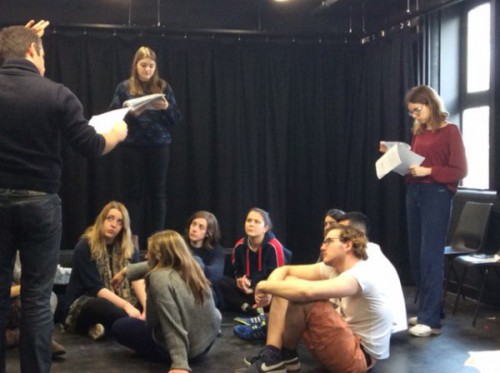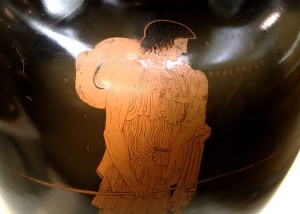
April 20, 2016, by Nikki Rollason
Oedipus showing at the Lakeside
Lynn Fotheringham attends a rehearsal of the Lakeside production of Oedipus and considers the process of fragmentation in modern approaches to tragedy.
After the Greek tragedy film season, Lakeside Arts is putting on another Greek tragedy this week: this year’s annual collaboration with the Nottingham New Theatre is Sophocles’ Oedipus (Steven Berkoff’s version) http://www.lakesidearts.org.uk/theatre/event/3172/oedipus.html. The project, which gives New Theatre students the opportunity to work with theatre professionals headed by director Martin Berry, started three years ago in 2013 with Aristophanes’ Lysistrata, in the translation of our own Alan Sommerstein; Doctor Faustus and Midsummer Night’s Dream followed in 2014 and 2015.
A few Sundays ago I was privileged to attend a rehearsal with the Oedipus company. It was only their second rehearsal: as with many professional productions, the bulk of the rehearsals will take place in the three weeks before the performance-run – which is why the performance run is the first week after the Easter vacation. So this rehearsal was exploratory, discussing and experimenting with different ways of handling a set of scenes, with final decisions yet to be made.
One aspect of the rehearsal interested me because of my own interest in the way that modern takes on the ancient world often involve a process of fragmentation. In tragedy, what most needs to be fragmented are the long speeches delivered by single characters. In our world, the long speech is a less common communication technique than the ‘soundbite’ (although this phenomenon was not unknown in the ancient world, as explored in a conference at the University of London next month); contemporary dramatic entertainment is dominated by fast editing rather than sustained focus on one individual speaking. In theatre there are a variety of ways in which long speeches can be broken down into shorter chunks that are more digestible for a modern audience.
One approach (which could have been taken in the ancient theatre) is simply to add pauses and movement. Another is to add action on stage at the same time as the speech, giving the audience something to look at; the 2011 Berkoff production of Oedipus at the Playhouse used this technique, e.g. miming the action narrated in messenger-speeches. A third approach is to divide up a speech originally intended for one character, so different actors deliver different bits of it. This technique is often used in contemporary productions for the Chorus, since the rehearsal process seldom leaves enough time for the actors to practice delivering the lines in a convincing and comprehensible unison chant. The new Oedipus production is still experimenting with all these techniques.
The Chorus can also be fragmented by having individuals emerge from it to play the speaking roles; this doubling of roles reflects another aspect of ancient performance convention, in which a change of costume and mask allowed the same actor to come back on stage in a different part. The old conventions are re-worked and re-imagined for a contemporary production, and if this involves some fragmentation, that’s entirely appropriate. After all, our entire experience of the ancient world is fragmented: we have only a fraction of what once existed. The Oedipus itself is a fragment: one play from a trilogy which was itself one of three trilogies performed in competition at a religious festival, forming a very different context from our own experience of theatre. Since that context cannot be reconstructed, we have to build our own using contemporary tools. I look forward to finding out what solutions the Lakeside/New Theatre team ultimately come up with. I’m going tonight (Wednesday), but there are four more performances still to catch before Saturday evening!
Book tickets here.
Photo: Martin Berry directs members of the Oedipus company in an early rehearsal at the New Theatre (photo by Shona Powell).
Additional image: shepherd with baby Oedipus, attic red-figure amphora, mid-5th century BC (photo by Bibi Saint-Pol, Wikimedia Commons).

No comments yet, fill out a comment to be the first

Leave a Reply